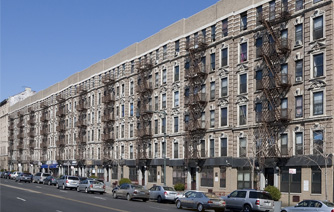
Image Credit: Jonathan Rose Companies
One of the realities of apartment living is that you and your neighbors all have something in common: your building’s failings and amenities. That may be why the occupants of a row of six-story buildings on W. 135th Street, between Lenox and Seventh avenues in New York City, are ready for the green upgrade that is scheduled to come their way this winter.
The 10 buildings – which were constructed almost 100 years ago and have been showing their age (via leaky fixtures, drafty entries, and worn out finishes) to their occupants – were acquired in December 2008 by the Rose Smart Growth Investment Fund, a division of Jonathan Rose Companies, which specializes in green development and planning, transit-oriented development, green design, and property management.
With the help of an interim renewal, and then a 20-year extension, of the building’s Section 8 contract with the Department of Housing and Urban Development, the developer says, the property will retain its affordable-housing status for the long term. What’s more, the investment fund is expected to soon begin a $39.4 million retrofit of the building that will include the installation of a rooftop solar panel system, replacement of old floor tiles and worn wood finishes with sustainable materials, and replacement of the buildings’ 32 boilers with 10 energy saving models. The collection of row houses includes 198 units, for a total of 159,000 sq. ft. of residential space, plus 4,500 sq. ft. of retail.
“We’re hoping our project will be a model for the entire country,” Wendy Rowden, the investment fund’s managing director, recently told the New York Daily News. It’s also possible, she added, that the improvement project might qualify for federal stimulus money – as much as $3 million — through the Green Retrofit Program for Multifamily Housing.
Preserving Old New York
Once the improvements are complete, these Harlem row houses will in many ways fit the developer’s profile of ideal urban housing, not only because they will be more energy efficient, but also because they already offer easy access to subway service and are historically significant buildings in an old New York neighborhood.
The “original architectural fabric” of the structures has not been lost on the project’s principal architect, Bill Stein, the News points out.
“It’s really a fantastic place to live and a great place to make a statement about the possibilities of sustainable design,” Stein told the paper, noting that the improvement plans include restoring the buildings’ vestibules and cornices.
One other touch, suggested by the project’s energy advisers, will be the installation of an LCD screen in a storefront that will show how much energy is being produced by the PV system.
Weekly Newsletter
Get building science and energy efficiency advice, plus special offers, in your inbox.














0 Comments
Log in or create an account to post a comment.
Sign up Log in